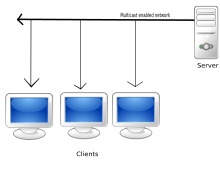Protocols
The audio stream is compressed using an audio codec such as MP3, Vorbis or AAC.The video stream is compressed using a video codec such as H.264 or VP8.
Encoded audio and video streams are assembled in a container bitstream such as MP4, FLV, WebM, ASF or ISMA.
The bitstream is delivered from a streaming server to a streaming client using a transport protocol, such as MMS or RTP. Newer technologies such as HLS, Microsoft's Smooth Streaming, Adobe's HDS and finally MPEG-DASH have emerged to enable adaptive bitrate streaming over HTTP as an alternative to using proprietary transport protocols.
The streaming client may interact with the streaming server using a control protocol, such as MMS or RTSP.
Protocol problems
Designing a network protocol to support streaming media raises many problems, such as:- Datagram protocols, such as the User Datagram Protocol (UDP), send the media stream as a series of small packets. This is simple and efficient; however, there is no mechanism within the protocol to guarantee delivery. It is up to the receiving application to detect loss or corruption and recover data using error correction techniques. If data is lost, the stream may suffer a dropout.
- The Real-time Streaming Protocol (RTSP), Real-time Transport Protocol (RTP) and the Real-time Transport Control Protocol (RTCP) were specifically designed to stream media over networks. RTSP runs over a variety of transport protocols, while the latter two are built on top of UDP.
- Another approach that seems to incorporate both the advantages of using a standard web protocol and the ability to be used for streaming even live content is adaptive bitrate streaming. HTTP adaptive bitrate streaming is based on HTTP progressive download, but contrary to the previous approach, here the files are very small, so that they can be compared to the streaming of packets, much like the case of using RTSP and RTP.
- Reliable protocols, such as the Transmission Control Protocol (TCP), guarantee correct delivery of each bit in the media stream. However, they accomplish this with a system of timeouts and retries, which makes them more complex to implement. It also means that when there is data loss on the network, the media stream stalls while the protocol handlers detect the loss and retransmit the missing data. Clients can minimize this effect by buffering data for display. While delay due to buffering is acceptable in video on demand scenarios, users of interactive applications such as video conferencing will experience a loss of fidelity if the delay caused by buffering exceeds 200 ms.
- Unicast protocols send a separate copy of the media stream from the server to each recipient. Unicast is the norm for most Internet connections, but does not scale well when many users want to view the same television program concurrently.
- Multicast protocols were developed to reduce the server/network loads resulting from duplicate data streams that occur when many recipients receive unicast content streams independently. These protocols send a single stream from the source to a group of recipients. Depending on the network infrastructure and type, multicast transmission may or may not be feasible. One potential disadvantage of multicasting is the loss of video on demand functionality. Continuous streaming of radio or television material usually precludes the recipient's ability to control playback. However, this problem can be mitigated by elements such as caching servers, digital set-top boxes, and buffered media players.
- IP Multicast provides a means to send a single media stream to a group of recipients on a computer network. A multicast protocol, usually Internet Group Management Protocol, is used to manage delivery of multicast streams to the groups of recipients on a LAN. One of the challenges in deploying IP multicast is that routers and firewalls between LANs must allow the passage of packets destined to multicast groups. If the organization that is serving the content has control over the network between server and recipients (i.e., educational, government, and corporate intranets), then routing protocols such as Protocol Independent Multicast can be used to deliver stream content to multiple Local Area Network segments.
- As in mass delivery of content, multicast protocols need much less energy and other resources, widespread introduction of reliable multicast (broadcast-like) protocols and their preferential use, wherever possible, is a significant ecological and economic challenge.
- Peer-to-peer (P2P) protocols arrange for prerecorded streams to be sent between computers. This prevents the server and its network connections from becoming a bottleneck. However, it raises technical, performance, security, quality, and business issues.


No comments:
Post a Comment